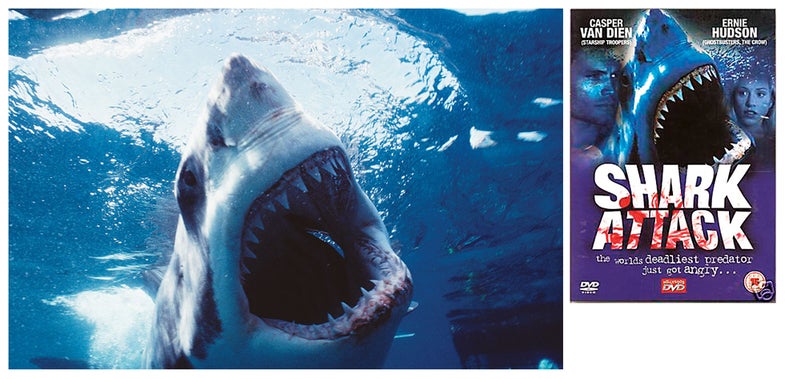Unfair Use
In February 1994, when he slipped into the ocean off southern Australia to photograph great white sharks, Carl Roessler knew...






In February 1994, when he slipped into the ocean off southern Australia to photograph great white sharks, Carl Roessler knew he could get hurt. And he did, but not that day, and not in the form of a shark bite. In fact, it was a decade before he even realized anything was wrong. One of the pictures from that shoot, of a great white attacking Roessler’s cage, teeth bared, became the photographer’s most widely distributed image—because an enormous number of people stole it.
At first, Roessler didn’t think much of the photo. “I usually kept the best ones for myself,” he says. “I knew it was a good shot, but I had others I thought were better, so I sent it off to an agent.” For four years, “Maddened Attack” was just another shark photo in a library of thousands. Then in 1998 Apple contacted Roessler’s agency about a one-year license to use the photo in print ads for their new PowerBook G3. Apple digitized and polished the image, doctoring some of the shark’s broken teeth, and ran with it. Roessler happily cashed the check and forgot all about the photo again.
But Apple’s timing proved fateful. Its license on “Maddened Attack” expired in 1999, just as the Internet was transforming from an obscure playground for computer hobbyists into a pirate’s paradise of friction-free file sharing. Napster, the era’s posterboy, was rising to prominence as the first program to facilitate large-scale free and unfettered music downloading—and with it came a new attitude toward content.
Like all those millions of “shared” MP3s, Apple’s digitized, repaired version of Roessler’s photo escaped into this nascent digital wilderness. There, aided by countless Internet-savvy, image-hungry designers, it traveled far and wide. By 2009, whenever he showed the photo, he heard “we’ve seen it all over the place.” Alarmed, Roessler began working with an agent whose subssequent digging showed that the image had, unbeknownst to him, spread among thousands of blogs and websites, been remixed into cartoons and paintings, shown up on billboards, and become the face of commercial products from off-brand batteries to mouse pads to guitars. Even mainstream clothing companies had picked up the image and used it without requesting permission to use it, paying any licensing fees or providing attribution. “Once I started looking for infringements of my copyright, I found them everywhere,” he says.
Roessler’s story is far from unique. It’s not even particularly unusual. While the Internet has made it easier than ever for artists to promote their work, it also has never been so easy for others to pirate their images. For the past decade, our systems for distributing photos have become incredibly sophisticated, while the technology for selling and tracking them has stayed in the digital dark ages. The harsh reality is that in order to participate in the most vibrant parts of today’s online marketplace, shooters must at least partially cede control of their work.
Illegal appropriation of photos is almost as old as photography itself. In 1862 a French studio firm, Mayer and Pierson, brought the first photo copyright case in France’s highest court against competitors who had copied its portraits of European dignitaries.
The case launched a heated debate in both the courts and the public. Was photography merely mechanical reproduction, independent of the person operating the camera? Or was it an artistic creation of the photographer, making it subject to copyright protections? The court found in favor of Mayer and Pierson, but the decision was so contentious that it took 50 more years for the precedent to take hold.
Echoes of the debate resonate even today. As the digital revolution has liberated content from physical media and mechanical reproduction becomes easier, the perception of a work’s monetary value, it appears, has diminished. Our ability to copy any image seems to have erased our sense of propriety about when and how we can use others’ work.
“There are a lot of myths out there about what constitutes fair use,” says Carolyn E. Wright, a professional photographer and intellectual property attorney who runs the website photoattorney.com. “A lot of people mistakenly think that if there’s no attribution or copyright mark on the image, or if they plan to use the image noncommercially, then it’s fine.”
It’s hard to get accurate estimates about the total amount of unlicensed photo use throughout the U.S. or the world, but the ongoing battle between high-profile photo agencies and those who would misuse their images is instructive. A report on the state of image infringement by the photo-tracking software company PicScout (recently purchased by Getty Images) notes that of the 5 million rights-managed stock images they surveyed in 2009, approximately 80 percent of those appearing on commercial websites were not being used legitimately.
Stock agency Masterfile uses PicScout’s ImageTracker service to locate their images on the Internet. Company president Steve Pigeon says that in 2011 Masterfile found 75 to 100 unlicensed uses per week, almost 5,000 for the year. “Annually for North America, retroactive license fees are about 25% of our total rights-managed sales,” he says.
Interestingly, Masterfile’s 2011 infringement numbers for the second half of 2011 were down about 30 percent from 2010, when the company brought more than 7,000 infringement cases. Pigeon says it’s too soon to say whether this drop is an anomaly but notes that it did coincide with the industry trend of using micro-stock services, making it easier for everyday consumers to license images.
A brighter future may also be on the horizon for the images in other stock libraries. Getty’s PicScout recently launched a new service called ImageExchange, a browser plugin for stock photo buyers that scans all the images on a given website and attempts to identify them. Once a photo is identified, the plugin provides an easy path to purchasing a license where possible.
Unfortunately, what’s viable for large stock agencies isn’t necessarily practical for independent photographers, already suffering price depression, strapped for time and lacking the resources to take strong action against unlicensed use. “Most photographers I know are more interested in creating new images than in litigating copyright infringements,” says Wright. “What we need is an easy way to license images for designers, like iTunes did for the music industry.”
Advertising photographer Jeff Sedlik agrees. “I could go online today and probably find 100 infringements of my images without much effort,” he laments. After exploring his current policing options—diligently registering his images with the copyright office, systematically searching out unlicensed use through Google and threatening unlicensed users with legal action—he found them entirely inadequate. But instead of complaining about it, Sedlik is spearheading a solution. His Picture Licensing Universal System (PLUS) is a coalition that has developed global standards and a registry connecting images to the photographers that took them and their associated rights information. It’s currently in beta testing with about 6,000 users (more info is available at plusregistry.org).
“Most big companies, which are the primary market for commercial images, don’t want to infringe on copyrights,” Sedlik says. “As photographers, we have a responsibility to help clients avoid infringements by providing clear, accurate information about the rights attached to them.”
The problem may not ever be completely solved, but this kind of new support technology implies a slightly brighter future. Improved image search abilities and sites like PLUS may increase the perceived value of photography and help photographers get the credit they’re due. Unfortunately, photographers of the current era, like Roessler and Noam Galai may never fully recover control of their images and may have to resign themselves to a lifetime of seeing bootlegs on T-shirts and foreign book covers. Their only (cold) comfort is the perverse validation that people want their photos enough to steal them. To update Oscar Wilde’s famous maxim about the merits of being talked about: “The only thing worse than having your pictures stolen is not having your pictures stolen.” AP
The Shout Heard Round The World

Israel-born, New York-based photographer Noam Galai got a crash course in finding infringements after self-portraits he posted on Flickr started showing up in books and magazines, on T-shirts, at concerts, even as anti-govenment street art in Egypt. Rather than take infringers to court, he started a scream blog to catalog the myriad places his face has popped up. See more at screameverywhere.com.

More assorted unlicensed uses:



